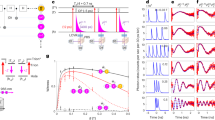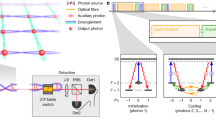Abstract
Photonic graph states—quantum light states where multiple photons are mutually entangled—are key resources for optical quantum technologies. They are notably at the core of error-corrected measurement-based optical quantum computing and all-optical quantum networks. In the discrete variable framework, these applications require the high-efficiency generation of cluster states whose nodes are indistinguishable photons. Such photonic cluster states can be generated with heralded single-photon sources and probabilistic quantum gates, yet with challenging efficiency and scalability. Spin–photon entanglement has been proposed to deterministically generate linear cluster states. First demonstrations have been obtained with semiconductor spins, achieving high photon indistinguishability, and most recently with atomic systems with a high collection efficiency and record length. Here we report on the efficient generation of three-partite cluster states made of one semiconductor spin and two indistinguishable photons. We harness a semiconductor quantum dot inserted in an optical cavity for efficient photon collection and electrically controlled for high indistinguishability. We demonstrate two- and three-particle entanglement with fidelities of 80 ± 4% and 63 ± 5%, respectively, with photon indistinguishability of 88 ± 0.5%. Owing to the high operation rate allowed by the quantum-dot platform, the spin–photon and spin–photon–photon entanglement rates exceed, by three and two orders of magnitude, respectively, those of the previous state of the art. Our system and experimental scheme, a monolithic solid-state device controlled with a resource-efficient simple experimental configuration, are very promising for future scalable applications.
This is a preview of subscription content, access via your institution
Access options
Access Nature and 54 other Nature Portfolio journals
Get Nature+, our best-value online-access subscription
$29.99 / 30 days
cancel any time
Subscribe to this journal
Receive 12 print issues and online access
$209.00 per year
only $17.42 per issue
Buy this article
- Purchase on Springer Link
- Instant access to full article PDF
Prices may be subject to local taxes which are calculated during checkout




Similar content being viewed by others
Data availability
All data acquired and used in this work are available upon reasonable request to P.S. (pascale.senellart-mardon@c2n.upsaclay.fr) or N.C. (nathan.coste@c2n.upsaclay.fr).
References
Raussendorf, R., Browne, D. E. & Briegel, H. J. Measurement-based quantum computation on cluster states. Phys. Rev. A 68, 022312 (2003).
Azuma, K., Tamaki, K. & Lo, H.-K. All-photonic quantum repeaters. Nat. Commun. 6, 6787 (2015).
Greenberger, D. M, Horne, M. A & Zeilinger, A. Going Beyond Bell’s Theorem (Springer, 1989).
Briegel, H. J. & Raussendorf, R. Persistent entanglement in arrays of interacting particles. Phys. Rev. Lett. 86, 910–913 (2001).
Raussendorf, R., Bravyi, S. & Harrington, J. Long-range quantum entanglement in noisy cluster states. Phys. Rev. A 71, 062313 (2005).
Raussendorf, R., Harrington, J. & Goyal, K. Topological fault-tolerance in cluster state quantum computation. New J. Phys. 9, 199 (2007).
Newman, M., de Castro, L. A. & Brown, K. R. Generating fault-tolerant cluster states from crystal structures. Quantum 4, 295 (2020).
Rudolph, T. Why I am optimistic about the silicon-photonic route to quantum computing. APL Photonics 2, 030901 (2017).
Zhang, R. et al. Loss-tolerant all-photonic quantum repeater with generalized Shor code. Optica 9, 152–158 (2022).
Zhong, H.-S. et al. 12-photon entanglement and scalable scattershot boson sampling with optimal entangled-photon pairs from parametric down-conversion. Phys. Rev. Lett. 121, 250505 (2018).
Senellart, P., Solomon, G. & White, A. High-performance semiconductor quantum-dot single-photon sources. Nat. Nanotechnol. 12, 1026–1039 (2017).
Knill, E., Laflamme, R. & Milburn, G. J. A scheme for efficient quantum computation with linear optics. Nature 409, 46–52 (2001).
Knill, E. Quantum gates using linear optics and postselection. Phys. Rev. A 66, 052306 (2002).
Istrati, D. et al. Sequential generation of linear cluster states from a single photon emitter. Nat. Commun. 11, 5501 (2020).
Schön, C., Solano, E., Verstraete, F., Cirac, J. I. & Wolf, M. M. Sequential generation of entangled multiqubit states. Phys. Rev. Lett. 95, 110503 (2005).
Lindner, N. H. & Rudolph, T. Proposal for pulsed on-demand sources of photonic cluster state strings. Phys. Rev. Lett. 103, 113602 (2009).
Browne, D. E. & Rudolph, T. Resource-efficient linear optical quantum computation. Phys. Rev. Lett. 95, 010501 (2005).
Gao, W. B., Fallahi, P., Togan, E., Miguel-Sanchez, J. & Imamoglu, A. Observation of entanglement between a quantum dot spin and a single photon. Nature 491, 426–430 (2012).
De Greve, K. et al. Quantum-dot spin–photon entanglement via frequency downconversion to telecom wavelength. Nature 491, 421–425 (2012).
Schaibley, J. R. et al. Demonstration of quantum entanglement between a single electron spin confined to an InAs quantum dot and a photon. Phys. Rev. Lett. 110, 167401 (2013).
Appel, M. H. et al. Entangling a hole spin with a time-bin photon: a waveguide approach for quantum dot sources of multiphoton entanglement. Phys. Rev. Lett. 128, 233602 (2022).
Schwartz, I. et al. Deterministic generation of a cluster state of entangled photons. Science 354, 434–437 (2016).
Cogan, D., Su, ZE., Kenneth, O. et al. Deterministic generation of indistinguishable photons in a cluster state. Nat. Photon. https://doi.org/10.1038/s41566-022-01152-2 (2023).
Yang, C.-W. et al. Sequential generation of multiphoton entanglement with a Rydberg superatom. Nat. Photon. 16, 658–661 (2022).
Thomas, P., Ruscio, L., Morin, O. & Rempe, G. Efficient generation of entangled multiphoton graph states from a single atom. Nature 608, 677–681 (2022).
Nowak, A. K. et al. Deterministic and electrically tunable bright single-photon source. Nat. Commun. 5, 3240 (2014).
Dousse, A. et al. Controlled light–matter coupling for a single quantum dot embedded in a pillar microcavity using far-field optical lithography. Phys. Rev. Lett. 101, 267404 (2008).
Somaschi, N. et al. Near-optimal single-photon sources in the solid state. Nat. Photon. 10, 340–345 (2016).
Thomas, S. et al. Bright polarized single-photon source based on a linear dipole. Phys. Rev. Lett. 126, 233601 (2021).
Coste, N. et al. Probing the dynamics and coherence of a semiconductor hole spin via acoustic phonon-assisted excitation. Quantum Sci. Technol. 8, 025021 (2023).
Blinov, B. B., Moehring, D. L., Duan, L. M. & Monroe, C. Observation of entanglement between a single trapped atom and a single photon. Nature 428, 153–157 (2004).
Wang, B.-Y., Denning, E. V., Gür, U. M., Lu, C.-Y. & Gregersen, N. Micropillar single-photon source design for simultaneous near-unity efficiency and indistinguishability. Phys. Rev. B 102, 125301 (2020).
Wein, S. C. et al. Analyzing photon-count heralded entanglement generation between solid-state spin qubits by decomposing the master-equation dynamics. Phys. Rev. A 102, 033701 (2020).
Ollivier, H. et al. Reproducibility of high-performance quantum dot single-photon sources. ACS Photonics 7, 1050–1059 (2020).
Hilaire, P. et al. Deterministic assembly of a charged-quantum-dot-micropillar cavity device. Phys. Rev. B 102, 195402 (2020).
Zaporski, L., Shofer, N., Bodey, J.H. et al. Ideal refocusing of an optically active spin qubit under strong hyperfine interactions. Nat. Nanotechnol. 18, 257–263 (2023).
Acknowledgements
This work was partially supported by the the IAD-ANR support ASTRID programme Projet ANR-18-ASTR-0024 LIGHT, the QuantERA ERA-NET Cofund in Quantum Technologies project HIPHOP, the European Union’s Horizon 2020 FET OPEN project QLUSTER (grant no. 862035), the European Union’s Horizon 2020 Research and Innovation Programme QUDOT-TECH under the Marie Skłodowska-Curie grant agreement no. 861097 and the French RENATECH network, a public grant overseen by the French National Research Agency (ANR) as part of the ‘Investissements d’Avenir’ programme (Labex NanoSaclay, reference no. ANR-10-LABX-0035), the Plan France 2030 through the project ANR-22-PETQ-0006. N.C. acknowledges support from the Paris Ile-de-France Région in the framework of DIM SIRTEQ. S.C.W. acknowledges support from the Foundational Questions Institute Fund (grant no. FQXi-IAF19-01). S.E.E. acknowledges supported from the NSF (grant no. 1741656).
Author information
Authors and Affiliations
Contributions
N.C. and D.A.F. carried out experimental investigations, data analysis, methodology, visualization and writing. N.B. carried out data analysis, methodology, formal analysis, visualization, writing and supervision. S.C.W. and P.H. provided conceptualization, formal analysis and writing. R.F. provided conceptualization and formal analysis. M.G., B.G. and A.A. carried out formal analysis. N.S., I.S. and A.H. performed nano-processing. A.L. and M.M. carried out sample growth. S.E.E. contributed conceptualization and formal analysis. O.K. contributed to data analysis and methodology. L.L. carried out sample design, methodology, data analysis and formal analysis. P.S. performed nano-processing, data analysis, methodology, visualization, writing, supervision and funding acquisition.
Corresponding authors
Ethics declarations
Competing interests
N.S. is a co-founder and P.S. is a scientific advisor and co-founder of the company Quandela. The other authors declare no competing interests.
Peer review
Peer review information
Nature Photonics thanks Wolfgang Langbein and the other, anonymous, reviewer(s) for their contribution to the peer review of this work.
Additional information
Publisher’s note Springer Nature remains neutral with regard to jurisdictional claims in published maps and institutional affiliations.
Supplementary information
Supplementary Information
Supplementary Figs. 1–3, Tables 1–3, model, derivation of fidelity lower bounds.
Rights and permissions
Springer Nature or its licensor (e.g. a society or other partner) holds exclusive rights to this article under a publishing agreement with the author(s) or other rightsholder(s); author self-archiving of the accepted manuscript version of this article is solely governed by the terms of such publishing agreement and applicable law.
About this article
Cite this article
Coste, N., Fioretto, D.A., Belabas, N. et al. High-rate entanglement between a semiconductor spin and indistinguishable photons. Nat. Photon. 17, 582–587 (2023). https://doi.org/10.1038/s41566-023-01186-0
Received:
Accepted:
Published:
Issue Date:
DOI: https://doi.org/10.1038/s41566-023-01186-0
This article is cited by
-
Dynamic resonance fluorescence in solid-state cavity quantum electrodynamics
Nature Photonics (2024)
-
A versatile single-photon-based quantum computing platform
Nature Photonics (2024)
-
Telecom-band quantum dot technologies for long-distance quantum networks
Nature Nanotechnology (2023)
-
When matter and information merge into “Quantum”
Communications Physics (2023)
-
Resource-efficient fault-tolerant one-way quantum repeater with code concatenation
npj Quantum Information (2023)



